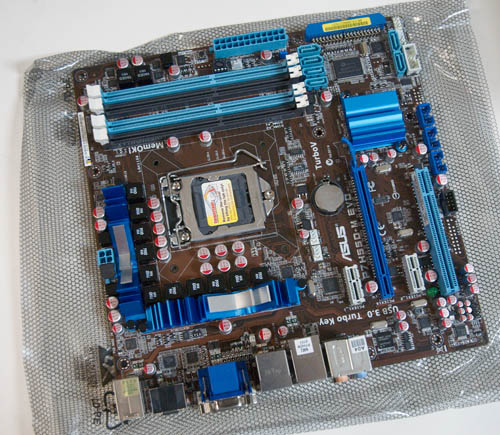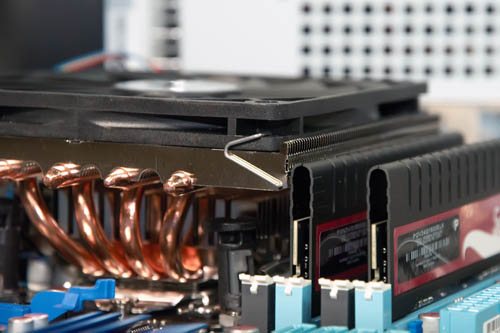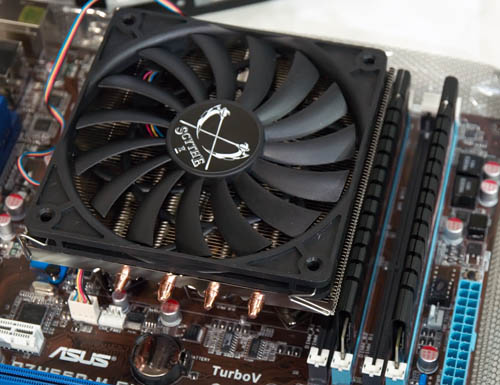The Pain of Assembly
Building a small form factor system is an exercise in flowcharts. If you’re using a highly compact case, like the Silverstone SG04B, the order of assembly is critical. The power supply, for example, goes in last.
The Asus motherboard offers a fairly clean layout, so there’s ample room for a large CPU cooler. However, I discovered late in the game that the SATA ports are poorly located, which means a long graphics card butts up to some of the SATA connectors. The board has plenty of ports, however, and does support USB 3.0, with an onboard NEC USB 3.0 controller.

Attaching the CPU cooler was challenging, too. I’ve generally liked Scythe coolers, but the designers often don’t think about how you actually mount the HSF. The Shiruken is a very low profile cooler, just 58mm high, including the skinny, 120mm fan. However, it’s fairly large, at 4.7 inches square. Plus, the Intel mounting tabs are under the radiator.
All this meant two things: I needed to install the HSF before installing the motherboard in the case.
Installing the cooler was an exercise in patience. I needed a large, flat bladed screwdriver, because there was no way I was going to get my fingers in between the HSF radiator and the top of the mounting pushpin, and still exert enough force to press the connector down until it snapped into place. Even then, I wasn’t 100% sure that all four pushpins had locked down.
And the Patriot memory modules, with their slightly taller silhouette, meant that two of the memory sockets weren’t usable. Lower profile memory modules would have allowed me to install four modules instead of two, if I wanted to go beyond 4GB.


Once the heat sink, CPU and memory were in place, the motherboard slid into the case nicely. It’s definitely a snug fit, since the case is just the right size for a micro ATX motherboard.
The biggest pain, though, was installing the Radeon HD 5850 graphics card. The XFX card is based on the reference design, and is 9.5 inches long. However, the power connectors are on the rear of the card. This had two consequences: you needed to attach the PCIe power plugs before installing the card in the case. Secondly, getting the card into the case meant slipping the card in at an angle, holding cables out of the way, and making sure you didn’t bump SATA or front panel connectors.
Due to the location of the SATA ports, I had to route the SATA cables over the top of the graphics card. Otherwise, I’d need to run them under the card, and that space is already pretty crowded.

The Silverstone case mounts hard drives in the base of the case, which is removable. However, as with the motherboard tray, space is tight, so you need to attach SATA and drive power after you close up the case bottom. I needed to be very careful, as the power adapter and SATA plug have barely enough room. It would be very easy to damage a SATA drive connector.
Once I figured out cable routing and got the graphics card running – which took several cycles of installing and removing the card, then re-routing cables – I booted the system. Everything was good. Installing Windows went smoothly.
The OCZ drive is fast, too. It’s in a 3.5-inch shell, rather than the more common 2.5 inch mechanism, and is really two 128GB modules pre-configured inside the shell for RAID 0. (Users never see the RAID configuration.)










81 Comments
View All Comments
mindless1 - Saturday, January 30, 2010 - link
The problem I have with it is it isn't really low power, it's only low idle power. Except when it comes time to pay the power bill idle power isn't a concern to many of us, even in this day and age where it's convenient to feel green.One other comment is I'll bet that CPU heatsink's fan will not last the life of the system, perhaps not half the life of the system. Given the cramped quarters to work in the case I hope there is enough clearance and mounting ability for a better replacement fan down the road, as it would be a real pain to have to pull the whole thing apart to get the heatsink off if it can't take a different fan (or else who wants to replace a bad fan with the same/equivalent thing again).
pjladyfox - Thursday, January 28, 2010 - link
That makes sense so you basically traded off space/flexability and cooling for portability. Not a trade I would have made but when put into that perspective it does make sense.aguilpa1 - Wednesday, January 27, 2010 - link
..., cause we still don't know if it was really worth it or not??aguilpa1 - Wednesday, January 27, 2010 - link
also, a couple of weeks ago I bought a 256GB Corsair P256 SSD for $625 from Newegg, 220/200 Read/Write with TRIM for my Alienware laptop, you could have saved a few bucks and some spaceLunyone - Wednesday, January 27, 2010 - link
Reminds me of paper launches of products, but without any performance specs. I appreciate the details noted during the installation process, but not to have any performance numbers to see where this lines up with the rest is sorta saddening. :(muro - Wednesday, January 27, 2010 - link
interesting build, I would also like to see benchmarks.I also wanted to do something similar, but went a different route:
* MSI X58M - mATX, Crossfire support (I don't plan to use it) and has 6 RAM slots (got 12GB of RAM)
* i7 920 - higher power use perhaps, but 4cores, 8threads. I paid almost the same price, about 220
* 5870 instead of 5850 - maybe I should have gone with SSD instead, but I have a 30'' screen
* Antec p180 mini - this case is big, big, big. The biggest case I ever had and it's micro ATX only. The "mini" part is a joke.
the whole cost was about 1500 (CHF, which is about 1:1 with USD). I might still upgrade to a SSD, but not for the prices they ask now (funny, it's actually the same price as the 5870, which I didn't mind that much paying for)
Robear - Wednesday, January 27, 2010 - link
A few suggestions if I may....1) Needs benchmarks. ANY benchmarks. This is about as useful as someone bragging on the boards about their new rig with some do's and don'ts about specific hardware. The most interesting thing about this rig was that ~40% of the cost was in the SSD. Was it worth it? How did it perform? What controller does the drive use? Is it on a 6Gb/s interface or are you bottlenecked at the interface? That would be my main concern with the drive.
2) It looks like it was done in word and then exported to HTML ;) Maybe a little cleanup to fit nicely on the site.
3) Did I mention benchmarks? They don't need to be fancy with comparisons to 3290472347845 other similar products. Just give us what it scored.
4) What about overclocking? Temps would be the big question here in the small case.
Anyway the article was lean so I can't come up with anything more than criticism. Sorry :(
teejaded - Wednesday, January 27, 2010 - link
I remember reading Loyd Case's articles in CGW when I was in junior high 15 years ago. Maybe then, this would have been acceptable, but IMO Loyd's writing on this site seems like such a joke compared to the amazing technical information we usually get.Unrelated, but in the article where he flattened and reinstalled Vista to fix a slowness problem really annoyed me. He didn't even try to fix it! Seriously, procexp kernrate procmon windbg driver verifier perfmon autoruns maybe... just do something for science sake. Anyone with half a brain can reinstall Windows and we don't need to read about it, especially on a site like this.
loydcase - Wednesday, January 27, 2010 - link
As I noted in the article, I'll be writing a follow-up with benchmarks and usage experiences.I doubt, however, I'll try much in the way of overclocking. I could maybe get a speed grade out of this system, but the constraints of the case means airflow isn't all that robust, and I'm trying to keep noise levels down.
marc1000 - Wednesday, January 27, 2010 - link
I liked the article because I have interest in SFF building - the pure bench numbers can be seen well spread in a dozen sites, just google it!Loyd, you did not put enough pictures of the case itself, googling it I saw some images and would suggest two things to test if it can help in overclocking:
1. add another intake fan at the front
2. reverse the PSU to suck air out of the CPU area, if possible
as the case is so small, you could need to use some plastic to create a path for the cold air to go to the CPU and GPU.
BTW, nice build!!